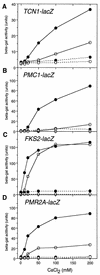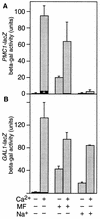Tcn1p/Crz1p, a calcineurin-dependent transcription factor that differentially regulates gene expression in Saccharomyces cerevisiae
- PMID: 9407036
- PMCID: PMC316804
- DOI: 10.1101/gad.11.24.3445
Tcn1p/Crz1p, a calcineurin-dependent transcription factor that differentially regulates gene expression in Saccharomyces cerevisiae
Abstract
Ca2+ signals regulate gene expression in animal and yeast cells through mechanisms involving calcineurin, a protein phosphatase activated by binding Ca2+ and calmodulin. Tcn1p, also named Crz1p, was identified as a transcription factor in yeast required for the calcineurin-dependent induction of PMC1, PMR1, PMR2A, and FKS2 which confer tolerance to high Ca2+, Mn2+, Na+, and cell wall damage, respectively. Tcn1p was not required for other calcineurin-dependent processes, such as inhibition of a vacuolar H+/Ca2+ exchanger and inhibition of a pheromone-stimulated Ca2+ uptake system, suggesting that Tcn1p functions downstream of calcineurin on a branch of the calcium signaling pathway leading to gene expression. Tcn1p contains three zinc finger motifs at its carboxyl terminus resembling the DNA-binding domains of Zif268, Swi5p, and other transcription factors. When fused to the transcription activation domain of Gal4p, the carboxy terminal domain of Tcn1p directed strong calcineurin-independent expression of PMC1-lacZ and other target genes. The amino-terminal domain of Tcn1p was found to function as a calcineurin-dependent transcription activation domain when fused to the DNA-binding domain of Gal4p. This amino-terminal domain also formed Ca2+-dependent and FK506-sensitive interactions with calcineurin in the yeast two-hybrid assay. These findings suggest that Tcn1p functions as a calcineurin-dependent transcription factor. Interestingly, induction of Tcn1p-dependent genes was found to be differentially controlled in response to physiological Ca2+ signals generated by treatment with mating pheromone and high salt. We propose that different promoters are sensitive to variations in the strength of Ca2+ signals generated by these stimuli and to effects of other signaling pathways.
Figures







References
-
- Alepuz PM, Cunningham KW, Estruch F. Glucose repression affects ion homeostasis in yeast through the regulation of the stress activated ENA1 gene. Mol Microbio. 1997;26:91–98. - PubMed
-
- Bading H, Ginty DD, Greenberg ME. Regulation of gene expression in hippocampal neurons by distinct calcium signaling pathways. Science. 1993;260:181–186. - PubMed
-
- Carafoli E, Garcia-Martin E, Guerini D. The plasma membrane calcium pump: recent developments and future perspectives. Experientia. 1996;52:1091–1100. - PubMed
Publication types
MeSH terms
Substances
Grants and funding
LinkOut - more resources
Full Text Sources
Other Literature Sources
Molecular Biology Databases
Miscellaneous
